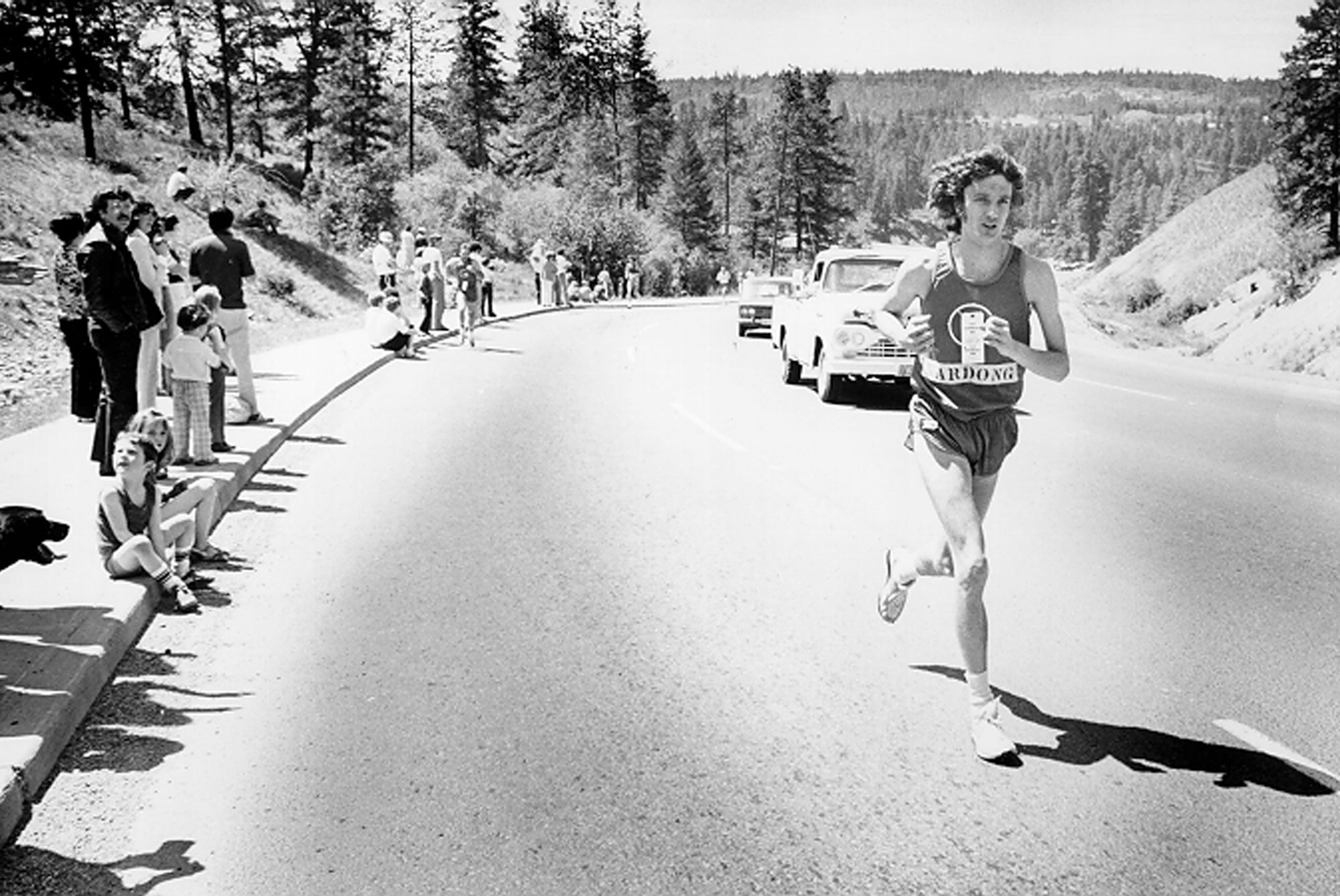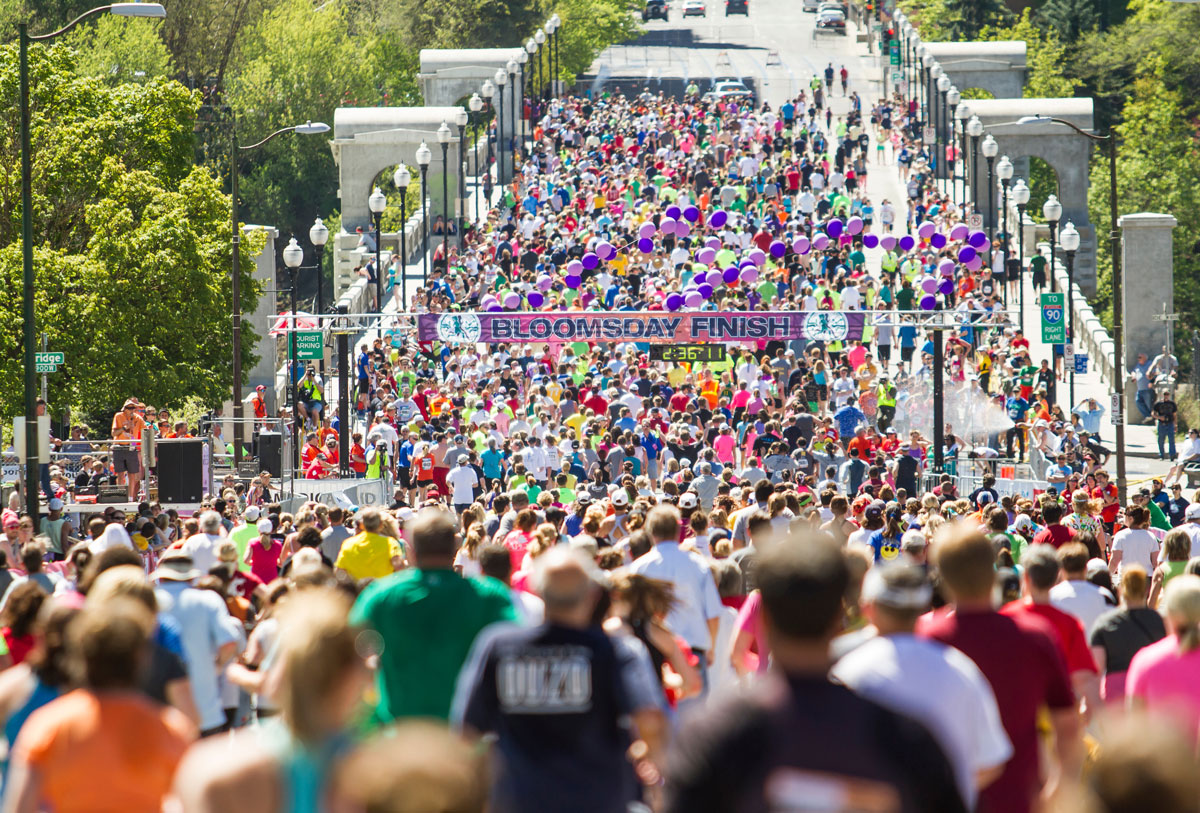

One morning each May, the city of Spokane transforms from an inland metropolis with a vibrant downtown core into a mecca for runners. Tens of thousands of people lace up their sneakers and funnel onto Riverside Avenue for the start of an annual event that has, over the last 47 years, stopped traffic, spawned generations of runners and drawn elite athletes from around the world.
As the starter pistol sounds at 9 a.m. at the Lilac Bloomsday Run, participants toss their jackets and sweatshirts into the trees (later collected and donated) and the thunder of more than 30,000 pairs of feet signal the return of a beloved Spokane tradition, one that started with UW alumnus Don Kardong, ’74.
Kardong grew up in Bellevue. During his sophomore year at Seattle Prep, his basketball coach asked him whether he would turn out for cross country. “Looking back on it, it was an odd thing to have said,” Kardong says. “But I found out that I was much better at running than I was at basketball.” His school was close enough to the UW, that he would run through the arboretum and the Lower Woodland Park track. Later on, when he was attending the UW, he ran some of the same routes. He started just at the dawn of the modern running shoe and at just ahead of the 1970s running boom.

Runners fill the streets at the 2013 Bloomsday Run 12k in Spokane.
He was the fastest on his high school team, “but my times weren’t great,” he says. He didn’t get any scholarship offers and wasn’t even sure he’d run in college. But one of his coaches encouraged him to walk on at Stanford. There he transitioned to college-level competition and by the time he was a sophomore, his five-member team finished second in the nation. In senior year, he came in a close second behind Steve Prefontaine at a Pac-8 meet.
After college, Kardong stayed in the Bay Area for a year training with the hopes of making the 1972 U.S. Olympic team. But his efforts were sabotaged by mononucleosis. Instead, he moved back to Seattle and enrolled at the UW to pursue a teaching certificate and a BA in English. “I was running every day, usually twice a day,” he says. “Five miles in the morning before class and 10 miles of track work at the end of the day.” Kardong trained with a few of the UW runners, mainly Jim Johnson, a Husky steeplechase champ. They took turns pacing each other at different events in all-comers meets.
“We got a group together and planned a route. We had no idea we were headed into a running boom.”
Don Kardong
Meanwhile, one of Kardong’s Stanford teammates had grown up in Spokane and invited him to come work at Camp Reed, a YMCA summer camp on Fan Lake. “I decided I liked the area really well,” says Kardong. “Spokane had quite a reputation for distance running. But when I got there, I couldn’t find all the runners.” Nonetheless, he did find a job teaching at Loma Vista Elementary and managed to run twice a day through most of the year, continuing to train for the Olympics. “It was pretty easy to get outside of town to areas that were fun to train in, and it wasn’t too crowded in terms of traffic.” His favorite place to run was Riverside State Park where the trails are dirt and rough, but the scenery is stunning.
In the Summer Olympics in 1976, Kardong finished a close fourth in the marathon. That same summer, he was invited to running events around the country. His favorite, the 10K Peachtree Road Race in Atlanta, got him thinking: The mix of about 2,000 recreational and Olympic-caliber runners filling the streets of the community “struck me as a brilliant way to encourage people to get engaged and have fun in the downtown city core,” he says. Back in Spokane, he told a newspaper reporter how perfect a similar downtown run would be in Spokane. The writer quoted him in the paper, the mayor voiced support and soon Kardong’s phone was ringing.
“We got a group together and planned a route,” he says. “Running was just getting started. We had no idea we were headed into a running boom.”
In 1977, Kardong and a gritty group of volunteers launched the Bloomsday run. “I didn’t have the organizational skills to do it, but a lot of people encouraged me and got involved,” he says. Kardong remembers the plan was to limit the event to a few hundred runners. “But we got all these entries coming in,” he says. “We ended up with almost 1,200 finishers. It was quite a surprise.” The second year drew 5,000 participants and “just blew all the systems [for tracking the runners] apart. The third year brought 10,000. “We were kind of making up how to do this with all our volunteers,” he says. They’d reach out to race directors in New York and Boston, but they were just figuring it out as well.
Planning the 7.46-mile course was fairly easy. But the Maple Street Bridge across the Spokane River had a narrow on-ramp and runners further back in the pack reported that the light posts on the bridge were vibrating so much they looked like they were going to snap off. So the route has changed slight from the original.
Meanwhile, Kardong had moved out of teaching and, with another runner, opened up a boutique running shop called Human Race and continued competing. The store venture didn’t pan out, but Kardong’s work as a race director and writer for Runners World and other publications did.
In 2019, Kardong stepped down as race director, but he continues to take part in the city’s annual event. At its peak, in 1996, attendance reached more than 60,000. Nowadays, it’s closer to 30,000 “Bloomies.” (For comparison, about 5,000 runners tackled the Seattle Marathon or Half Marathon in 2023.)
“There are people who have done every Bloomsday going back to 1977,” says Kardong. “I’m still doing it every year. One of the great thrills to me just liberating the streets for a morning every year.
“We kind of feel like we changed the culture and created an event that everybody looks forward to,” he says. “Long after I’m gone, they will be having Bloomsday.”